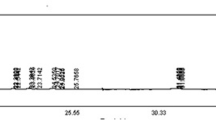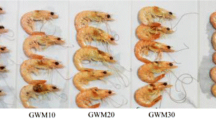Abstract
The present study was conducted to evaluate the feasibility of replacing fish meal (FM) with bioactive peptides (BPs) in diet of white shrimp (Litopenaeus vannamei). The changes in growth performance, body composition, non-specific immunity, and water quality were examined after the shrimp were fed four diets, in which 0% (control), 33.3%, 66.7% and 100% of FM was replaced by BPs, respectively. The groups were designated as Con, 1/3BPs, 2/3BPs, and 3/3BPs. A total of 720 shrimp with an initial body weight of 1.46 ± 0.78 g were fed the experimental diets for 56 days. The results revealed that: 1) the weight gain rate (WGR) in 1/3BPs, 2/3BPs, and 3/3BPs was significantly higher than that in Con (P < 0.05), while no significant difference was found on survival rate and feed conversion ratio (FCR); 2) the whole-body crude protein (CP) and crude lipids (CL) were significantly different among groups, while there was no significant difference between crude ash and phosphorus contents; 3) the levels of acid phosphatase (ACP), lysozyme (LZM), superoxide dismutase (SOD), phenol oxidase (PO) and bactericidal activity increased significantly with the inclusion of BPs; 4) in terms of water quality, no significant difference was found in pH and dissolved oxygen among diets during the whole experimental period. Moreover, even though nitrite and ammonium levels tended to increase with time, there was no significant difference among groups. The results indicated that BPs is an applicable alternative of protein source, which can substitute FM in the diets of L. vannamei; it is able to effectively promote growth performance and improve immunity. Moreover, BPs in the diets had no negative impact on water quality.
Similar content being viewed by others
References
Asche, F., Oglend, A., and Tveteras, S., 2013. Regime shifts in the fish meal/soybean meal price ratio. Journal of Agricultural Economics, 64: 97–111.
Ashida, M., 1990. The prophenoloxidase cascade in insect immunity. Research in Immunology, 141: 908–910.
Bowman, E. J., Siebers, A., and Altendorf, K., 1988. Bafilomycins: A class of inhibitors of membrane ATPases from microorganisms, animal cells, and plant cells. Proceedings of the National Academy of Sciences, 85: 7972–7976.
Brito, L. O., Arantes, R., Magnotti, C., Derner, R., Pchara, F., Olivera, A., and Vinatea, L., 2014. Water quality and growth of Pacific white shrimp (Boone) in co-culture with green seaweed (Linaeus) in intensive system. Aquaculture International, 22: 497–508.
Bulut, M., Yigit, M., Ergün, S., Kesbiç, O. S., Acar, Ü., Karga, M., and Güroy, D., 2014. Incorporation of corn gluten meal as a replacement for fish meal in the diets of two banded seabream (Diplodus vulgaris) juveniles. International Journal of AgriScience, 4: 60–65.
Burford, M. A., Revill, A. T., Smith, J., and Clementson, L., 2012. Effect of sewage nutrients on algal production, biomass and pigments in tropical tidal creeks. Marine Pollution Bulletin, 64: 2671–2680.
Campa-Córdova, A. I., Hernández-Saavedra, N. Y., De Philippis, R., and Ascencio, F., 2002. Generation of superoxide anion and SOD activity in haemocytes and muscle of American white shrimp (Litopenaeus vannamei) as a response to ß-glucan and sulphated polysaccharide. Fish & Shellfish Immunology, 12: 353–366.
Chen, Y. Y., Sim, S. S., Chiew, S. L., Yeh, S. T., Liou, C. H., and Chen, J. C., 2012. Dietary administration of a Gracilaria tenuistipitata extract produces protective immunity of white shrimp Litopenaeus vannamei in response to ammonia stress. Aquaculture, 370-371: 371–26.
Correia, E. S., Wilkenfeld, J. S., Morris, T. C, Wei, L. Z., Prangnell, D. I., and Samocha, T. M., 2014. Intensive nursery production of the Pacific white shrimp Litopenaeus vannamei using two commercial feeds with high and low protein content in a biofloc-dominated system. Aquacultural Engineering, 59: 48–54.
Cummins, V. C., Webster, C. D., Thompson, K. R., and Velasquez, A., 2013. Replacement of fish meal with soybean meal, alone or in combination with distiller’s dried grains with soluble in practical diets for Pacific white shrimp, Litopenaeus vannamei, grown in a clear-water culture system. Journal of the World Aquaculture Society, 44: 775–785.
Dai, Z. L., Li, X. L., Xi, P. B., Zhang, J., Wu, G. Y., and Zhu, W. Y., 2013. I-glutamine regulates amino acid utilization by intestinal bacteria. Amino Acids, 45: 501–512.
Draganovic, V., Boom, R. M., Jonkers, J., and van der Goot, A. J., 2014. Lupine and rapeseed protein concentrate in fish feed: A comparative assessment of the techno-functional properties using a shear cell device and an extruder. Journal of Food Engineering, 126: 178–189.
Garibaldi, L., 2012. The FAO global capture production database: A six-decade effort to catch the trend. Marine Policy, 36: 760–768.
Geysen, H. M., Barteling, S. J., and Meloen, R. H., 1985. Bioactive peptides products induce antibodies with a sequence and structural requirement for binding antigen comparable to antibodies raised against the native protein. Proceedings of the National Academy of Sciences, 82: 178–182.
Gildberg, A., 2004. Enzymes and bioactive peptides from fish waste related to fish silage, fish feed and fish sauce production. Journal of Aquatic Food Product Technology, 13: 3–11.
Jackson, A. J., 2006. The importance of fishmeal and fish oil in aquaculture diets. International Aquafeed, 9: 18–21.
Kotzamanis, Y. P., Gisbert, E., Gatesoupe, F. J., Infante, J. Z., and Cahu, C., 2007. Effects of different dietary levels of fish protein hydrolysates on growth, digestive enzymes, gut microbiota, and resistance to Vibrio anguillarum in European sea bass (Dicentrarchus labrax) larvae. Comparative Biochemistry and Physiology Part A: Molecular & Integrative Physiology, 147: 205–214.
Krummenauer, D., Samocha, T., Poersch, L., Lara, G., and Wasielesky, W., 2014. The reuse of water on the culture of Pacific white shrimp, Litopenaeus vannamei, in BFT system. Journal of the World Aquaculture Society, 5: 3–14.
Lin, S. M., Lin, X., Yang, Y., Li, F. J., and Luo, L., 2013. Comparison of chelated zinc and zinc sulfate as zinc sources for growth and immune response of shrimp (Litopenaeus vannamei). Aquaculture, 406: 79–84.
Moreira, N., Soares, S., Valente, L. M. P., Cunha, M. C., Cunha, L. M., and Pinho, P. G. D., 2014. Effect of two experimental diets (protein and lipid vegetable oil blends) on the volatile profile of Senegalese sole (Solea senegalensis Kaup, 1858. muscle. Food Chemistry, 153: 327–333.
Najafian, L., and Babji, A. S., 2012. A review of fish-derived antioxidant and antimicrobial peptides: Their production, assessment, and applications. Peptides, 33: 178–185.
National Environmental Protection Agency (NEPA), 1987. Water quality–Determination of the ammonium (GB7479-87). Beijing, China.
Ørskov, C., Holst, J. J., Knuhtsen, S., Baldissera, F. G. A., Poulsen, S. S., and Nielsen, O. V., 1986. Glucagon-like peptides GLP-1 and GLP-2, predicted products of the glucagon gene, are secreted separately from pig small intestine but not pancreas. Endocrinology, 119: 1467–1475.
Oudot, C., and Montel, Y., 1988. A high sensitivity method for the determination of nanomolar concentrations of nitrate and nitrite in seawater with a technicon autoanalyzer II. Marine Chemistry, 24: 239–252.
Pokorny, A., Cherry, M., Higgins, S., Melroy, H., and Lee, H. S., 2014. Peptides with the same composition, hydrophobicity, and hydrophobic moment bind to phospholipid bilayers with different affinities. Biophysical Journal, 106: 86.
Purcell, A. W., McCluskey, J., and Rossjohn, J., 2007. More than one reason to rethink the use of peptides in vaccine design. Nature Reviews Drug Discovery, 6: 404–414.
Rajanbabu, V., and Chen, J. Y., 2011. Applications of antimicrobial peptides from fish and perspectives for the future. Peptides, 32: 415–420.
Relling, A. E., and Reynolds, C. K., 2008. Abomasal infusion of casein, starch and soybean oil differentially affect plasma concentrations of gut peptides and feed intake in lactating dairy cows. Domestic Animal Endocrinology, 35: 35–45.
Samocha, T. M., Davis, D. A., Saoud, I. P., and DeBault, K., 2004. Substitution of fish meal by co-extruded soybean poultry by-product meal in practical diets for the Pacific white shrimp, Litopenaeus vannamei. Aquaculture, 231: 197–203.
Senevirathne, M., and Kim, S. K., 2012. Chapter 15-development of bioactive peptides from fish proteins and their health promoting ability. Advances in Food and Nutrition Research, 65: 235–248.
Shepherd, C. J., and Jackson, A. J., 2013. Global fishmeal and fish-oil supply: Inputs, outputs and marketsa. Journal of Fish Biology, 83: 1046–1066.
Walker, P. J., and Winton, J. R., 2010. Emerging viral diseases of fish and shrimp. Veterinary Research, 41: 51.
Wimley, W. C., and Hristova, K., 2011. Antimicrobial peptides: Successes, challenges and unanswered questions. The Journal of Membrane Biology, 239: 27–34.
Wrighton, N. C., Farrell, F. X., Chang, R., Kashyap, A. K., Barbone, F. P., Mulcahy, L. S., Johnson, D. L., Barrett, R. W., Jolliffe, L. K., and Dower, W. J., 1996. Bioactive peptides products as potent mimetics of the protein hormone erythropoietin. Science, 273: 458–463.
Zhang, S. P., Li, J. F., Wu, X. C., Zhong, W. J., Xian, J. A., Liao, S. A., Miao, Y. T., and Wang, A. L., 2013. Effects of different dietary lipid level on the growth, survival and immune-relating genes expression in Pacific white shrimp, Litopenaeus vannamei. Fish & Shellfish Immunology, 34: 1131–1138.
Author information
Authors and Affiliations
Corresponding author
Rights and permissions
About this article
Cite this article
Wang, G., Yu, E., Li, Z. et al. Effect of bioactive peptides (BPs) on the development of Pacific white shrimp (Litopenaeus vannamei Boone, 1931). J. Ocean Univ. China 15, 495–501 (2016). https://doi.org/10.1007/s11802-016-2854-7
Received:
Revised:
Accepted:
Published:
Issue Date:
DOI: https://doi.org/10.1007/s11802-016-2854-7




